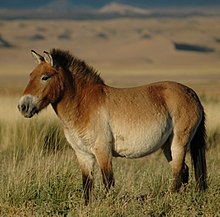
Equidae is the taxonomic family of horses and related animals, including the extant horses, asses, and zebras, and many other species known only from fossils. The family evolved around 50 million years ago from a small, multi-toed ungulate into larger, single-toed animals. All extant species are in the genus Equus, which originated in North America. Equidae belongs to the order Perissodactyla, which includes the extant tapirs and rhinoceros, and several extinct families. It is more specifically grouped within the superfamily Equoidea, the only other family being the extinct Palaeotheriidae.

Proboscidea is a taxonomic order of afrotherian mammals containing one living family (Elephantidae) and several extinct families. First described by J. Illiger in 1811, it encompasses the elephants and their close relatives. Three species of elephant are currently recognised: the African bush elephant, the African forest elephant, and the Asian elephant.

Merychippus is an extinct proto-horse of the family Equidae that was endemic to North America during the Miocene, 15.97–5.33 million years ago. It had three toes on each foot and is the first horse known to have grazed.
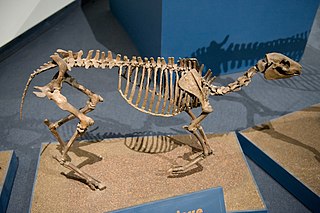
Miohippus is an extinct genus of horse existing longer than most Equidae. It lived in what is now North America from 32 to 25 million years ago, during the late Eocene to late Oligocene. According to the Florida Museum of Natural History, Othniel Charles Marsh first believed Miohippus lived during the Miocene and thus named the genus using this incorrect conclusion. More recent research provides evidence that Miohippus actually lived during the Paleogene period.

Orohippus is an extinct equid that lived in the Eocene.
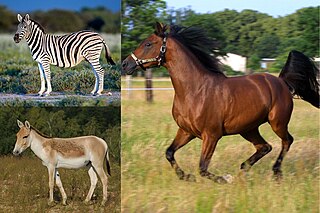
Equus is a genus of mammals in the family Equidae, which includes horses, asses, and zebras. Within the Equidae, Equus is the only recognized extant genus, comprising seven living species. Like Equidae more broadly, Equus has numerous extinct species known only from fossils. The genus originated in North America and dispersed into the Old World and South America during the Early and Middle Pleistocene. Equines are odd-toed ungulates with slender legs, long heads, relatively long necks, manes, and long tails. All species are herbivorous, and mostly grazers, with simpler digestive systems than ruminants but able to subsist on lower-quality vegetation.
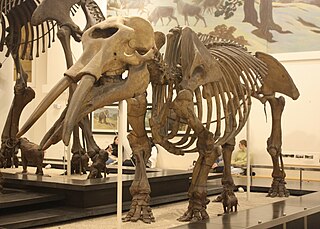
Gomphotheres are an extinct group of proboscideans related to modern elephants. First appearing in Africa during the Oligocene, they dispersed into Eurasia and North America during the Miocene and arrived in South America during the Pleistocene as part of the Great American Interchange. Gomphotheres are a paraphyletic group ancestral to Elephantidae, which contains modern elephants, as well as Stegodontidae.
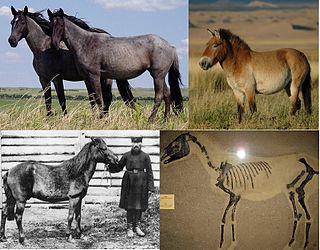
The wild horse is a species of the genus Equus, which includes as subspecies the modern domesticated horse as well as the endangered Przewalski's horse. The European wild horse, also known as the tarpan, that went extinct in the late 19th or early 20th century has previously been treated as the nominate subspecies of wild horse, Equus ferus ferus, but more recent studies have cast doubt on whether tarpans were truly wild or if they actually were feral horses or hybrids.

Hipparion is an extinct genus of three-toed, medium-sized equine belonging to the extinct tribe Hipparionini, who lived about 10-5 million years ago. While the genus formerly included most hipparionines, the genus is now more narrowly defined as hipparionines from Eurasia spanning the Late Miocene. Hipparion was a mixed-feeder who ate mostly grass, and lived in the savannah biome. Hipparion evolved from Cormohipparion, and went extinct due to environmental changes like cooling climates and decreasing atmospheric carbon dioxide levels.

Equus namadicus is a prehistoric equid, known from remains dating to the Middle and Late Pleistocene from across the Indian subcontinent, with its last dated records being approximately 29-14,000 years ago. It is considered a "stenonine horse", meaning that it is probably more closely related to zebras and asses than true horses. It is relatively large in size. It is very similar to the earlier Equus sivalensis, also from the Indian subcontinent, from which it only differs in size and in subtle aspects of dental anatomy, and it has sometimes been suggested to be a synonym of it.

Hippidion is an extinct genus of equine that lived in South America from the Late Pliocene to the end of the Late Pleistocene (Lujanian), between 2.5 million and 11,000 years ago. They were one of two lineages of equines native to South America during the Pleistocene epoch, alongside Equus (Amerhippus) neogeus.

The evolution of the horse, a mammal of the family Equidae, occurred over a geologic time scale of 50 million years, transforming the small, dog-sized, forest-dwelling Eohippus into the modern horse. Paleozoologists have been able to piece together a more complete outline of the evolutionary lineage of the modern horse than of any other animal. Much of this evolution took place in North America, where horses originated but became extinct about 10,000 years ago, before being reintroduced in the 15th century.

Cormohipparion is an extinct genus of horse belonging to the tribe Hipparionini that lived in North America during the late Miocene to Pliocene. They grew up to 3 feet long.

The Anchitheriinae are an extinct subfamily of the Perissodactyla family Equidae, the same family which includes modern horses, zebras and donkeys. This subfamily is more primitive than the living members of the family. The group first appeared with Mesohippus in North America during the middle Eocene and thrived until the late Miocene. The subfamily continued in Eurasia with the genus Sinohippus until the early Pliocene, when it finally became extinct. This subfamily are considered browsers with their more ancestral low-crowned molars, in contrast with the modern, specialized grazer species of modern Equinae.

Megahippus is an extinct genus of large Anchitheriine horses found throughout the southern portion of the United States during the middle Miocene. The animal represents one of the latest low-crowned horses, overlapping in time with more derived high-crowned horses.
Astrohippus is an extinct member of the Equidae tribe Equini, the same tribe that contains the only living equid genus, Equus. Fossil remains have been found in the central United States, Florida, and the Mexican states of Chihuahua, Jalisco, and Guanajuato. The fossils date in time from the oldest dating from the Barstovian in the Miocene to the youngest dating in the Hemphillian faunal stage of the early Pliocene.

Equini is the only living tribe of the subfamily Equinae, which has lived worldwide since the Hemingfordian stage of the Middle Miocene. It is considered to be a monophyletic clade.

Notiomastodon is an extinct genus of gomphothere proboscidean, endemic to South America from the Pleistocene to the beginning of the Holocene. Notiomastodon specimens reached a size similar to that of the modern Asian elephant, with a body mass of 3-4 tonnes. Like other brevirostrine gomphotheres such as Cuvieronius and Stegomastodon, Notiomastodon had a shortened lower jaw and lacked lower tusks, unlike more primitive gomphotheres like Gomphotherium.
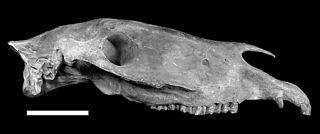
Equus neogeus is an extinct species of equine native to South America during the Pleistocene. It was formerly thought to be several distinct species within the subgenus Amerhippus, but was later shown to be a single morphologically variable species. It is thought to be closely related to true horses.

Hipparionini is a tribe of three-toed horses in the subfamily Equinae. They had body forms similar to modern equines, with high-crowned teeth. They first appeared in North America during the Early Miocene around 17 million years ago, before migrating into the Old World around 11.4-11.0 million years ago. The youngest species date to the Early Pleistocene, becoming extinct following the arrives of modern equines of the genus Equus to the Old World.
